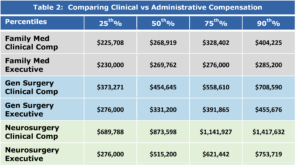Many hospitals and health systems often require specific physician services on an infrequent, intermittent basis. The frequency and/or unpredictable schedule for these services may pose staffing challenges that require an arrangement with an outside provider. As these arrangements are subject to AKS and Stark regulations governing compensation for referral sources, facilities must take care to structure the compensation in a manner consistent with Fair Market Value (FMV)/Commercial Reasonableness (CR). Often the very nature of these arrangements can pose various challenges that can make setting an appropriate hourly rate difficult. Some of the factors to consider include the number of hours or frequency of the service, differentiating between clinical and administrative value, and other specific facts and circumstances associated with the service.
Impact of number of hours or frequency
Dr. Janice Smith, a practicing endocrinologist, is being asked to provide diabetes care to patients of a family practice clinic one half day a week. The family practice needs her support on a limited bases as she is the only endocrinologist in the service area.
Hourly compensation is often utilized for intermittent staffing services that do not require the services of a full-time provider. Depending on how much or how little of the provider’s time is required, the FMV range for the hourly rate for the intermittent service could exceed the full-time hourly rate compensation. Securing the services of a physician for half of a day one day per week vs retaining that same physician for 3 full days per week for 6 months may require a higher hourly rate with all other factors held equal. A very common example is seen in hourly staffing agreements. If the provider’s services are needed on a recurring, daily basis the compensation may be set relatively close to what they could otherwise generate in full-time clinical practice. However, if the services are less frequent, for example half-day blocks or only one time per week, then the compensation necessary to secure those services may be at a higher rate than the physician’s typical clinical earnings.
An illustration of the impact the number of hours and/or frequency of services has on the hourly rate can be seen in the premiums paid to locum tenens physicians. Locums rates for short-term assignments will command higher effective hourly rates than assignments that are long-term.

*Hourly rates for illustrative purposes only.
Administrative vs Clinical Compensation
A facility is building a heart transplant program from inception. In order to develop the service, the facility contracts with Dr. Jill Adams, cardiothoracic surgeon with administrative experience and 25 years of clinical practice.
Physician compensation can often differ based on the types of services being provided. Compensation from clinical services or administrative services should be in alignment with the requirements under the transaction. Although clinical and administrative compensation may be similar in lower compensated specialties (i.e. primary care), the greater the clinical compensation the greater the variance with the corresponding administrative compensation in the specialty. For example, compensation for surgical services can be substantially greater than compensation for administrative services. Table 2 illustrates the comparison between clinical and administrative compensation associated with three different specialties (i.e. Family Medicine, General Surgery, and Neurosurgery). The table illustrates this increasing variance.
Medical director compensation for surgical specialties, though higher on an hourly basis than medical director compensation for non-surgical specialties, is typically less than the compensation the surgeon receives for performing procedures.

Notes:
- Clinical compensation data comes from the MGMA 2022 Provider Compensation Survey, using 2021 data.
- Administrative compensation data comes from the MGMA 2022 Medical Directorship Survey, using 2021 data. Effective annual compensation based on 1,840 annual hours for illustration purposes.
Other considerations related to incremental services
For any service that is paid on an intermittent basis there could be other physician-specific and/or transaction-specific factors that might need to be considered when setting physician compensation. Some examples of various factors that could impact value include:
- Oversight requiring specialized clinical expertise (i.e. neuromodulation services in neurosurgery)
- Building a new service line from inception requiring a certain level of physician experience
- A shortage exists in the market for the physician specialty needed for the service
- There is urgency associated with providing the service
It is important to remember that when dealing with FMV issues each transaction is different and an analysis of all the factors will vary on a case-by-case basis.
Summary
Care should be taken when setting hourly rates for physician services, especially when those services are provided on an infrequent, intermittent basis. Consideration of all of the facts and circumstances of the services can help successfully navigate the potential compliance risks revolving around physician compensation.
Rob Holland, MBA, MPH, CVA – Director, HMS Valuation Partners


